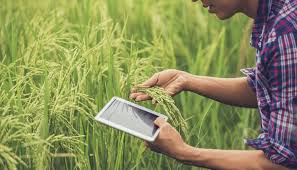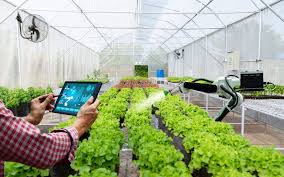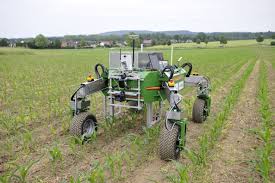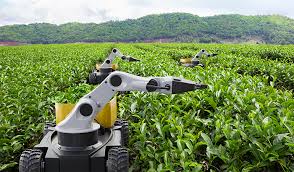Agricultural forecasting is made easy when farmers deploy AI/ML and data science technology. The use of 3D laser scanning and spectral imaging/spectral analysis, for example, can help farmers predict weather scenarios and optimize the use of resources required for irrigation, fertilization, and pest control.
Through AI/ML & data science technology, farmers can analyze their fields for the best locations for planting seeds. They can use computer vision to recognize plants’ optimal height, width, and spacing. This data can then be used to optimize their growing methods.
Key Benefits of AI/ML in Agriculture
1. Increased Productivity: AI and ML allow farmers to analyze real-time data on soil, weather, and crop conditions, helping them make quick and effective decisions to optimize crop yield. This precision reduces resource waste and maximizes productivity.
2. Reduced Environmental Impact: With AI-driven insights, farmers can minimize the use of fertilizers, pesticides, and water, which helps reduce pollution and conserves resources. This leads to more sustainable farming practices that benefit the environment.
3. Cost Savings: By automating labor-intensive tasks such as planting, watering, and pest control, AI and ML help reduce labor costs and improve efficiency. In the long term, these technologies contribute to lower operational costs.
4. Enhanced Crop Quality: AI enables precise control over crop management practices. By closely monitoring nutrient levels, plant health, and growth stages, farmers can ensure high-quality produce with consistent characteristics.
5. Real-Time Monitoring and Forecasting: AI provides farmers with timely information on weather patterns, pest outbreaks, and disease risks, allowing them to take preventive measures. Accurate forecasting enables better planning and risk management.
Applications of Data Science in Precision Farming

1. Yield Prediction Models: Data science leverages historical data and predictive analytics to estimate crop yield for a season. This information helps farmers plan resources, manage supply chains, and anticipate profits.
2. Soil and Water Analysis: Data science techniques, such as remote sensing and geospatial analysis, provide detailed insights into soil composition and moisture levels. This enables precise irrigation and fertilization, improving soil health and reducing water usage.
3. Pest and Disease Control: By analyzing data from satellite imagery and in-field sensors, data science helps detect patterns of pest activity and disease spread. This allows for timely intervention with targeted pesticide use, minimizing crop loss.
4. Optimizing Fertilizer Application: Precision farming uses data on soil nutrient levels and plant growth stages to apply fertilizers only where needed. This reduces over-fertilization, promotes soil health, and saves costs.
5. Crop Rotation and Field Management: Data science supports crop rotation planning based on soil nutrient depletion and crop compatibility, helping maintain soil fertility and improve long-term farm productivity.
Role of AI in Crop Monitoring and Disease Detection
1. Remote Sensing for Plant Health: AI-driven remote sensing, often via drones and satellites, captures multispectral images to monitor plant health. AI algorithms analyze these images for signs of stress, nutrient deficiencies, and potential disease outbreaks.
2. Early Disease Detection: Using image recognition technology, AI can identify symptoms of disease in plants, such as leaf spots or discoloration. Early detection helps farmers take quick action, preventing the spread of diseases across crops.
3. Pest Detection and Management: AI-powered systems can detect the presence of pests by analyzing data from sensors and images. By identifying pests early, farmers can implement targeted control methods, reducing the need for widespread pesticide use.
4. Automated Field Surveillance: AI-powered surveillance systems monitor crops around the clock, identifying anomalies that indicate plant stress or disease. These systems alert farmers to potential issues before they escalate.
5. Growth Stage Monitoring: AI algorithms track the growth stages of crops, allowing farmers to tailor their practices for each stage. By monitoring growth, farmers can optimize.resource allocation and enhance crop health and yield.
Read Also: The Techniques Used for Enhancing Farm Yield
Machine Learning for Soil Health Analysis

1. Soil Nutrient Analysis: Machine learning models analyze soil samples to identify nutrient levels, helping farmers determine specific fertilization needs. This precision prevents nutrient depletion and promotes balanced soil health.
2. Soil pH Monitoring: ML algorithms process data on soil pH and recommend adjustments for optimal crop growth. Maintaining the correct pH level is essential for nutrient absorption and crop productivity.
3. Erosion and Degradation Prediction: By analyzing historical soil data and environmental factors, machine learning models can predict areas at risk for erosion or degradation. Farmers can use this information to implement soil conservation practices.
4. Moisture Retention Analysis: ML models assess soil moisture retention capabilities based on soil type and crop requirements. Farmers use this information to optimize irrigation, ensuring crops receive adequate water without over-irrigation.
5. Precision Soil Mapping: Machine learning algorithms create detailed soil maps that highlight areas with varying nutrient and moisture levels. This helps farmers manage soil health more effectively by tailoring practices to specific field areas.
Predictive Analytics for Crop Yield Optimization
1. Understanding Predictive Analytics: Predictive analytics involves using historical and current data to forecast future outcomes. In agriculture, it applies to predicting crop yield based on factors such as weather, soil quality, and crop management practices.
2. Yield Prediction Models: Predictive models use historical yield data, local weather conditions, and soil health information to project the yield for upcoming seasons. This allows farmers to plan better, anticipate profits, and manage resources more effectively.
3. Climate and Weather Data Analysis: Predictive analytics considers weather patterns, temperature fluctuations, and rainfall forecasts to optimize crop planting and harvesting schedules. Farmers can reduce risks by making informed decisions based on predicted weather events.
4. Precision Fertilization and Watering: By predicting which areas of a field need more nutrients or water, predictive analytics helps farmers apply resources only where needed. This targeted approach reduces waste and enhances plant growth across fields.
5. Optimizing Crop Varieties: Predictive models can analyze how different crop varieties perform under specific conditions. Farmers use this information to choose varieties best suited for local soil and climate, maximizing yield potential.
Read Also: 16 Medicinal Health Benefits Of Pomaderris kumeraho (Kumerahou)
Robotics and Automation in Agriculture

1. Automated Planting Systems: Robotic planters use GPS and sensor data to plant seeds at the right depth and spacing, improving germination rates and ensuring uniform crop growth. Automated planting reduces labor costs and enhances precision.
2. Harvesting Robots: Robots equipped with sensors and AI technology can identify ripe fruits and vegetables, harvesting them gently to avoid damage. These robots work faster than human laborers, helping farmers meet tight harvest schedules.
3. Weed Control Robots: AI-powered robots equipped with cameras and sensors can distinguish between crops and weeds. They selectively remove weeds without disturbing the crops, reducing the need for chemical herbicides and promoting healthier crop growth.
4. Drones for Monitoring and Spraying: Agricultural drones collect high-resolution images of crops, enabling farmers to monitor growth and detect issues like nutrient deficiencies or disease. Some drones are also used for precise spraying, targeting only the affected areas with pesticides or fertilizers.
5. Labor Reduction and Efficiency: Automation reduces the need for manual labor in repetitive tasks like planting, watering, and harvesting. This efficiency allows farmers to manage larger areas and focus more on high-level farm management.
AI-Powered Irrigation Management
1. Sensor-Based Irrigation Systems: AI-powered irrigation systems use soil moisture sensors and weather data to optimize watering schedules. By providing the right amount of water only when needed, these systems conserve water and reduce costs.
2. Weather-Integrated Irrigation: AI algorithms analyze real-time weather data to adjust irrigation based on predicted rainfall and temperature. This prevents over-watering and helps maintain soil moisture balance for optimal crop growth.
3. Precision Drip Irrigation: AI-driven systems control drip irrigation lines, delivering water directly to plant roots. This targeted approach minimizes evaporation loss and ensures plants receive water more efficiently.
4. Remote Monitoring and Control: Farmers can monitor and adjust their irrigation systems remotely through smartphone apps, enabling quick responses to changes in weather or soil conditions. This flexibility ensures crops stay healthy, even when farmers are off-site.
5. Reducing Water Waste: By using data to determine precise watering needs, AI-powered irrigation helps reduce water waste and promotes sustainable water management practices. This is especially important in regions facing water scarcity.
Data-Driven Pest and Weed Control
1. Pest Prediction Models: Using historical pest data, weather patterns, and crop stage information, predictive models can forecast pest outbreaks. Farmers can take preventive measures, such as applying targeted pesticides, to reduce crop damage.
2. Early Pest Detection with Drones: Drones equipped with multispectral cameras and sensors capture detailed images of fields. AI software analyzes these images for signs of pest infestation, allowing farmers to intervene early and reduce crop loss.
3. Weed Identification and Removal: AI-powered systems analyze images of plants to distinguish between crops and weeds. Robots and sprayers can then target weeds with precision, minimizing the impact on crops and reducing herbicide use.
4. Integrated Pest Management (IPM): Data-driven pest control supports IPM strategies by enabling farmers to monitor pest populations and only intervene when necessary. This approach reduces the overuse of pesticides, promoting eco-friendly pest management.
5. Customized Pest Solutions: Data analysis allows farmers to identify specific pest species affecting their fields. By understanding the types of pests and their behaviors, farmers can use targeted treatments for more effective pest control.
Do you have any questions, suggestions, or contributions? If so, please feel free to use the comment box below to share your thoughts. We also encourage you to kindly share this information with others who might benefit from it. Since we can’t reach everyone at once, we truly appreciate your help in spreading the word. Thank you so much for your support and for sharing!
Read Also: Best Organic Fertilizer for Vegetables

